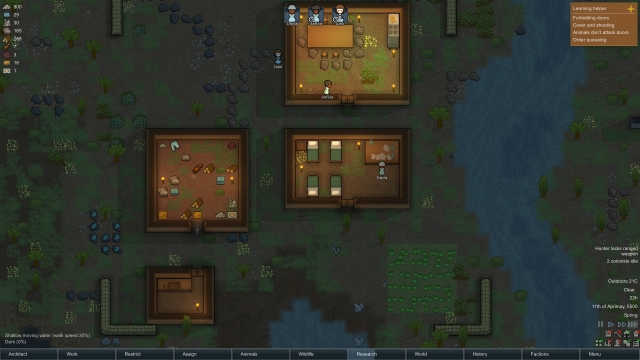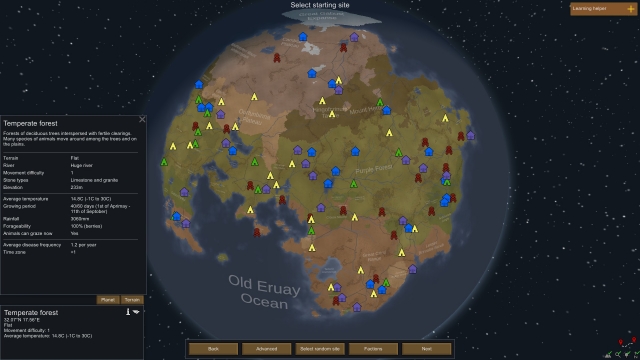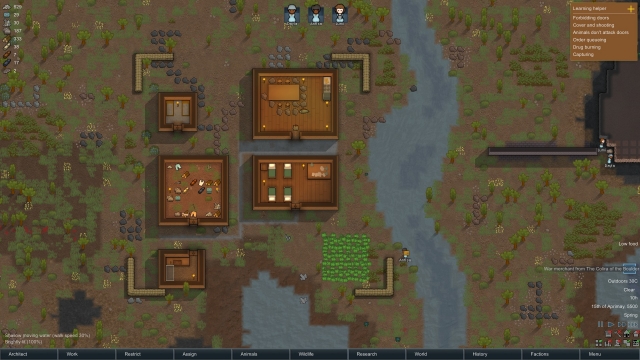
RimWorld Review
You’re trying to hastily construct defenses to hold off invaders that have caused you some grief when a raccoon goes rabid and chews your colonists legs off. This is typical of the shenanigans you can expect as you try to keep your colonists alive and happy in RimWorld.

In some ways it’s easy to see RimWorld as a simpler, friendlier take on the emergent simulation style Dwarf Fortress has made popular, and whilst that’s a little reductive it is still a fairly accurate description of what to expect. You start with a handful of colonists, each with various specialties and try to make a go of it as you crash land at your selected site on the titular planet.
As a base-building strategy game you are, unsurprisingly, initially tasked with building places for your colonists to sleep and hang out and ensuring your initial stockpile of supplies are safe before scouring the surface for further materials so you can aid your survivors on their strange new planet. Once the basics are in place you are then free to think about how you want to evolve your colony and work towards getting off the planet.

RimWorld makes a good first impression with its presentation and visuals. Getting into the game has you selecting a landing site and how aggressive the game’s AI Storyteller will throw problems at you.The screens for this look attractive and give you a lot of information.
The AI Storyteller has three personalities which affect how harsh the game is to start, how frequently you receive items and how tenacious critters in the world will be, amongst other things. Your choice of landing site likewise contributes to how hard you want to make survival, from temperate plains to unforgiving tundra you must nudge your colonists in different ways to make it in this new world.

Like Dwarf Fortress and other games of this ilk, you rarely directly control a specific colonist, giving orders like build a wall, place a table, butcher that human corpse, and laugh maniacally as one of them tries to fulfil the tasks you’ve given them. If you want a specific colonist to use a specific weapon or haul a specific object however, you have the power to do so, but in broad strokes you merely suggest what needs to happen and hope they get it together.
Each colonist has their own personality with wants and needs you can see and try to help with. Make your empathic, medical specialist butcher too many human corpses for kibble however and you might send them towards a mental break, but they might head in a more positive direction if you make sure their room is nicely decorated with a nice spot for their pet boar.
After toying with everyone’s mental state and ensuring they are prepared for the inevitable rabid raccoon attacks, you can examine the research tree. This allows you to brew alcohol, create drugs and invent technology to aid your colony. Each branch of the tree adds new things you can build, new developments to expand the materials you can use and gives you greater scope to make things you can sell to visiting factions as you try to get off the planet.
RimWorld has a charming look, the day/night cycle is a lovely visual flourish that looks a lot more impressive than you’d expect for such a simple effect. The visuals make watching your colonists mine, chop and grow resources whilst trying to stay sane playing horseshoes and performing butchery a pleasure but they highlight the game’s few major issues.

The user interface is clunky and all over the place. Whilst the charcoal slabs fit with the initial design of the screens as you create the world, the layout of the menus and how information is displayed isn’t good. You have 11 tabs along the bottom of the screen that pop up further information but it’s rarely obvious what lives in each.
For example, what is the difference between the Animals tab and the Wildlife tab? To build things you use the Architect tab, but you also use that to order colonists to perform tasks and designate zones for things like storage or growing plants. This does all become manageable once you figure it out, but it’s inconsistent and messy. Fortunately, the game does feature a lot of tooltips, which help you figure things out with a bit of experimentation.
The other major issue is one of initial direction. The game features a “Learning Helper” that offers information on game features as they become necessary or you trigger them doing something else but it doesn’t do a great job of explaining what you should be doing and how. You can figure a lot of this stuff out after failing a few times and giving the research tree a good once over, but it would be nice if there were a gentle nudge in the right direction.
RimWorld is a really fun sandbox survival experience and is a great place for folk who feel like Dwarf Fortress has too big of a learning curve or is too fantasy heavy. The lack of polish detracts from the experience but if you don’t mind a little bit of poking about to figure things out there is a lot of fun to be had here. Just watch out for those raccoons, they bite.
RimWorld (Reviewed on Windows)
This game is good, with a few negatives.
A satisfying colony-building sandbox with a lot of replayability that suffers from a lack of polish in the UI. A great aesthetic and quirky sci-fi take on the genre mean there is a lot to like here, it just takes a little digging to get there.












COMMENTS